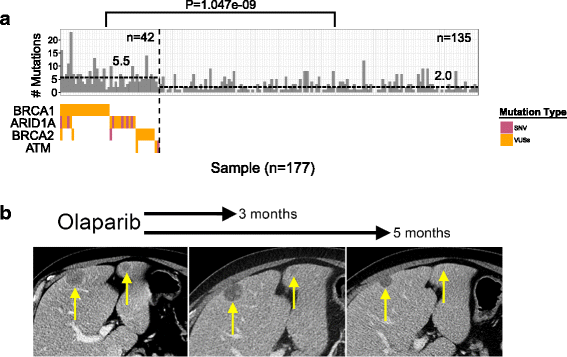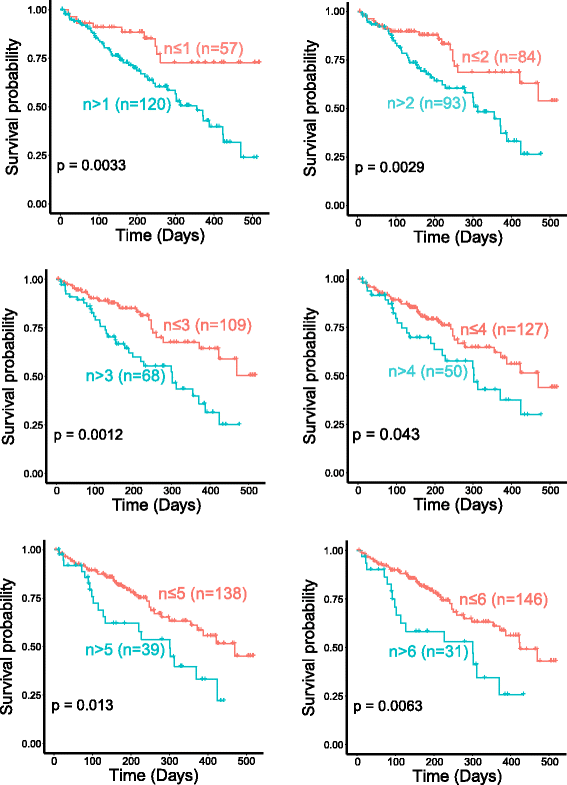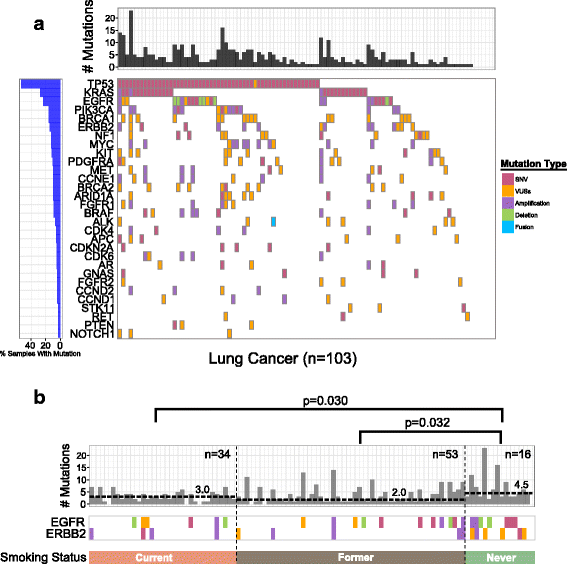Circulating mutational portrait of cancer: manifestation of aggressive clonal events in both early and late stages
- PMID: 28472989
- PMCID: PMC5418716
- DOI: 10.1186/s13045-017-0468-1
Circulating mutational portrait of cancer: manifestation of aggressive clonal events in both early and late stages
Abstract
Background: Solid tumors residing in tissues and organs leave footprints in circulation through circulating tumor cells (CTCs) and circulating tumor DNAs (ctDNA). Characterization of the ctDNA portraits and comparison with tumor DNA mutational portraits may reveal clinically actionable information on solid tumors that is traditionally achieved through more invasive approaches.
Methods: We isolated ctDNAs from plasma of patients of 103 lung cancer and 74 other solid tumors of different tissue origins. Deep sequencing using the Guardant360 test was performed to identify mutations in 73 clinically actionable genes, and the results were associated with clinical characteristics of the patient. The mutation profiles of 37 lung cancer cases with paired ctDNA and tumor genomic DNA sequencing were used to evaluate clonal representation of tumor in circulation. Five lung cancer cases with longitudinal ctDNA sampling were monitored for cancer progression or response to treatments.
Results: Mutations in TP53, EGFR, and KRAS genes are most prevalent in our cohort. Mutation rates of ctDNA are similar in early (I and II) and late stage (III and IV) cancers. Mutation in DNA repair genes BRCA1, BRCA2, and ATM are found in 18.1% (32/177) of cases. Patients with higher mutation rates had significantly higher mortality rates. Lung cancer of never smokers exhibited significantly higher ctDNA mutation rates as well as higher EGFR and ERBB2 mutations than ever smokers. Comparative analysis of ctDNA and tumor DNA mutation data from the same patients showed that key driver mutations could be detected in plasma even when they were present at a minor clonal population in the tumor. Mutations of key genes found in the tumor tissue could remain in circulation even after frontline radiotherapy and chemotherapy suggesting these mutations represented resistance mechanisms. Longitudinal sampling of five lung cancer cases showed distinct changes in ctDNA mutation portraits that are consistent with cancer progression or response to EGFR drug treatment.
Conclusions: This study demonstrates that ctDNA mutation rates in the key tumor-associated genes are clinical parameters relevant to smoking status and mortality. Mutations in ctDNA may serve as an early detection tool for cancer. This study quantitatively confirms the hypothesis that ctDNAs in circulation is the result of dissemination of aggressive tumor clones and survival of resistant clones. This study supports the use of ctDNA profiling as a less-invasive approach to monitor cancer progression and selection of appropriate drugs during cancer evolution.
Keywords: Clonality; Liquid biopsy; Lung cancer; Mutation rate; Non-invasive.
Figures






Similar articles
-
Next-generation sequencing of tissue and circulating tumor DNA: Resistance mechanisms to EGFR targeted therapy in a cohort of patients with advanced non-small cell lung cancer.Cancer Med. 2021 Jul;10(14):4697-4709. doi: 10.1002/cam4.3948. Epub 2021 Jun 25. Cancer Med. 2021. PMID: 34173341 Free PMC article.
-
Dynamics of circulating tumor DNA represented by the activating and resistant mutations in epidermal growth factor receptor tyrosine kinase inhibitor treatment.Cancer Sci. 2016 Mar;107(3):353-8. doi: 10.1111/cas.12860. Epub 2016 Feb 18. Cancer Sci. 2016. PMID: 26678713 Free PMC article.
-
[Detection of circulating tumor DNA in epidermal growth factor receptor-TKI relapsed non-small cell lung cancer patients using next-generation sequencing and an analysis of the resistant mechanisms].Zhonghua Bing Li Xue Za Zhi. 2018 Dec 8;47(12):904-909. doi: 10.3760/cma.j.issn.0529-5807.2018.12.002. Zhonghua Bing Li Xue Za Zhi. 2018. PMID: 30522169 Chinese.
-
Systemic Therapy for Lung Cancer Brain Metastases.Curr Treat Options Oncol. 2021 Oct 25;22(12):110. doi: 10.1007/s11864-021-00911-7. Curr Treat Options Oncol. 2021. PMID: 34693454 Review.
-
Liquid Biopsy to Identify Actionable Genomic Alterations.Am Soc Clin Oncol Educ Book. 2018 May 23;38:978-997. doi: 10.1200/EDBK_199765. Am Soc Clin Oncol Educ Book. 2018. PMID: 30231331 Free PMC article. Review.
Cited by
-
Role of Gamma Knife Radiosurgery in Small Cell Lung Cancer: A Multi-Institutional Retrospective Study of the International Radiosurgery Research Foundation (IRRF).Neurosurgery. 2020 Sep 15;87(4):664-671. doi: 10.1093/neuros/nyz428. Neurosurgery. 2020. PMID: 31599324 Free PMC article.
-
Comprehensive Analysis of Cancer-Proteogenome to Identify Biomarkers for the Early Diagnosis and Prognosis of Cancer.Proteomes. 2017 Oct 25;5(4):28. doi: 10.3390/proteomes5040028. Proteomes. 2017. PMID: 29068423 Free PMC article. Review.
-
Biophysical and epigenetic regulation of cancer stemness, invasiveness and immune action.Curr Tissue Microenviron Rep. 2020 Dec;1(4):277-300. doi: 10.1007/s43152-020-00021-w. Epub 2020 Nov 2. Curr Tissue Microenviron Rep. 2020. PMID: 33817661 Free PMC article.
-
Incorporating blood-based liquid biopsy information into cancer staging: time for a TNMB system?Ann Oncol. 2018 Feb 1;29(2):311-323. doi: 10.1093/annonc/mdx766. Ann Oncol. 2018. PMID: 29216340 Free PMC article. Review.
-
Clinical utility of tumor genomic profiling in patients with high plasma circulating tumor DNA burden or metabolically active tumors.J Hematol Oncol. 2018 Nov 6;11(1):129. doi: 10.1186/s13045-018-0671-8. J Hematol Oncol. 2018. PMID: 30400986 Free PMC article.
References
MeSH terms
Substances
Grants and funding
LinkOut - more resources
Full Text Sources
Other Literature Sources
Research Materials
Miscellaneous

